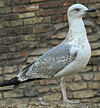 Yellow-legged
Gull - Larus michahellis
Yellow-legged
Gull - Larus michahellis
(last update: October 08 2013)
Coordinators:
Delfín González
Gabriel Martín
Antonio Gutierrez
Amir Ben Dov
Mars Muusse
Larus michahellis - 3CY January
This website deals with the Yellow-legged Gull taxon michahellis, which is a common migrant from July to December in NW Europe. After extensive expansion of the breeding population during the last three decades, it nowadays can be found breeding in Belgium, the Netherlands and Britain in mixed couples with both Herring Gull (argenteus) and Lesser Black-backed Gull (graellsii). There are subtle differences between the populations from the Mediterranean, Atlantic coast of Portugal and Morocco and from the islands in the Atlantic. Most pronounced differences can be found in the taxon atlantis, now regarded as full species by some authors and birds along the Atlantic coast of the Iberian peninsular: lusitanius. Both atlantis and lusitanius are treated in their own sections on this website.
General description
There is no extensive moult going on in 3CY birds during this month. The winter head streaking, which was obvious and concentrated on the ear-coverts, around the eye and up to the crown by September and October, has been worn away by mid winter, leaving an almost snow-white appearance. The most prominent streaking on the under-parts is the breast-band.
Moult stage and pace of remiges and rectrices
The primaries and secondaries are all second generation now, as are the rectrices. The white tips of the tail-feathers are worn way, half a year after they were moulted.
Timing and strategy of moult in January
Basically, the wing-coverts are at least second generation in January. However, michahellis is a taxon which often includes wing-coverts in the partial moult. Hence, many birds show third or even fourth generation wing-coverts (often in the same tracts as 1CY birds show second generation coverts; see 1CY October). Subsequently, the wing-coverts are a mix of fresh coverts with obvious white tips and older second generation coverts. Normally, the older coverts can be found in the carpal edge (outer lesser coverts) and the outer greater coverts. The inner median and inner lower lesser coverts may look more adult-like, sometimes plain grey in 3CY michahellis in January. However, these grey third and fourth generation feathers may still show a delicate diffuse brown pattern.
Normally, most of the scapulars are plain grey now. Some old barred third generation feathers may still be visible, often in the rear row of the lowest lower scapulars (just above the scapular coverts). See Topography Section for explanation of feather tracts.
Movements
By April, only very few 3CY michahellis can be found along the coasts of SW Netherlands and NW France. The majority remains at lower latitudes. Those which are present at Etaples (about 5-10 individuals by April 30 2003), probably belong to michahellis from the colonies of Marseille and the Mediterranean coast.
Tables
No tables.
 Yellow-legged Gull michahellis 3CY 023H January 16 2011, Jakuševec landfill, Zagreb, Croatia. Picture: ringing team Luka Jurinovic.
Yellow-legged Gull michahellis 3CY 023H January 16 2011, Jakuševec landfill, Zagreb, Croatia. Picture: ringing team Luka Jurinovic. Yellow-legged Gull michahellis 3CY 803H January 29 2013, Jakuševec-Zagreb, Croatia. Picture: ringing team Luka Jurinovic.
Yellow-legged Gull michahellis 3CY 803H January 29 2013, Jakuševec-Zagreb, Croatia. Picture: ringing team Luka Jurinovic. Yellow-legged Gull michahellis 3CY 804H January 29 2013, Jakuševec-Zagreb, Croatia. Picture: ringing team Luka Jurinovic.
Yellow-legged Gull michahellis 3CY 804H January 29 2013, Jakuševec-Zagreb, Croatia. Picture: ringing team Luka Jurinovic. Yellow-legged Gull michahellis 3CY, January 12 2015, Fori Imperiali - Rome, Italy. Picture: Dirk van Gansberghe.
Yellow-legged Gull michahellis 3CY, January 12 2015, Fori Imperiali - Rome, Italy. Picture: Dirk van Gansberghe. Yellow-legged Gull michahellis 3CY, January 12 2015, Fori Imperiali - Rome, Italy. Picture: Dirk van Gansberghe.
Yellow-legged Gull michahellis 3CY, January 12 2015, Fori Imperiali - Rome, Italy. Picture: Dirk van Gansberghe. Yellow-legged Gull michahellis 3CY, January 12 2015, Fori Imperiali - Rome, Italy. Picture: Dirk van Gansberghe.
Yellow-legged Gull michahellis 3CY, January 12 2015, Fori Imperiali - Rome, Italy. Picture: Dirk van Gansberghe. Yellow-legged Gull michahellis 3CY, January 25 2015, Fori Imperiali - Rome, Italy. Picture: Dirk van Gansberghe.
Yellow-legged Gull michahellis 3CY, January 25 2015, Fori Imperiali - Rome, Italy. Picture: Dirk van Gansberghe. Yellow-legged Gull michahellis 3CY, January 25 2015, Fori Imperiali - Rome, Italy. Picture: Dirk van Gansberghe.
Yellow-legged Gull michahellis 3CY, January 25 2015, Fori Imperiali - Rome, Italy. Picture: Dirk van Gansberghe. Yellow-legged
Gull michahellis 3CY, January 04 2002, Le Portel, NW France (50.44N-01.35E). Delayed plumage. The colour of
soft parts is still very immature.
Yellow-legged
Gull michahellis 3CY, January 04 2002, Le Portel, NW France (50.44N-01.35E). Delayed plumage. The colour of
soft parts is still very immature.